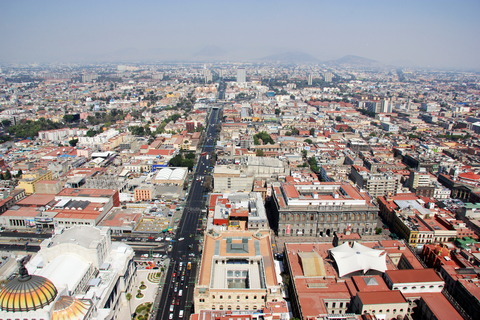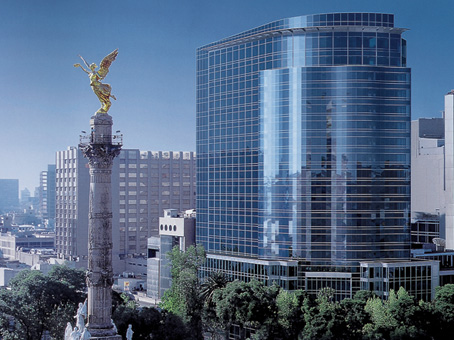
[Updated Oct 2020] A guide to flexible serviced offices and office space to rent in Mexico City as well as general information that may be useful if you are considering renting offices or workspace in the city.
For further Mexico City offices information or to search office space to rent in Mexico City just click. Or contact us for any office space rental query.
History & Geography
Mexico City is the largest city in the world, a teeming mass of humanity which is one of the most important economic and cultural entities in North America. The capital of Mexico is located in south-central Mexico in what is called the Basin of Mexico. Where the city now stands used to be Lake Texcoco, which completely drained in the 17th century. Mexico City was founded in 1325 by the Aztecs, who dubbed it Tenochtitlan. By the time the Spaniards arrived in the area Tenochtitlan had grown to a population of 250,000 people and was the centre of the Aztec Empire. In 1521 Spanish explorer Hernan Cortez laid siege to Tenochtitlan and the city fell that same year. Cortez then destroyed much of Tenochtitlan and renamed it ‘Mexico’. Under Spanish rule, Mexico City expanded and flourished. It became an important trading centre due to the fact that it was within reach of both the Atlantic and Pacific Oceans. The Spanish nobility built many palatial homes in Mexico City, some of which can still be seen today. In 1810 the Mexican War of Independence broke out which would last over ten years. It was not until 1821 that the Declaration of Independence of the Mexican Empire was signed. Soon after, in 1846 the Mexican-American war occurred, which ended in disaster for Mexico and the occupation of Mexico City by American forces. In 1876 Porfirio Diaz became president and started an ambitious plan to transform Mexico City to rival the great cities of Europe. Major building projects included roads, schools, and transportation systems. Diaz was overthrown during the Mexican Revolution which lasted from 1910 until 1920. During the rest of the 20th century, Mexico City grew astronomically. In 1900 the population of the city was 500,000, but by 1980 it had grown to over 8 million. Today Mexico City experiences serious environmental problems due to overcrowding and poor regulation. However, the city is still a dynamic, prosperous, icon of Mexico and one of the most important cities in the world.
Economy
Mexico City is extremely important to Mexico’s economy, currently, Mexico City has a GDP of USD 390 billion which puts it as the eighth richest city in the world. Mexico City is alone is the 30th largest economy in the world. This GDP is predicted to grow exponentially by 2020 as Mexico City has one of the fastest-growing economies of any city. During the 1990s the city’s economy shifted away from manufacturing to a more service-based economy. Due to the economic reforms of President Carlos Salinas de Gortari, most of Mexico’s factories moved to the country’s northern border. Additionally, many businesses, especially banks, were privatised. Today Mexico City is home to many corporate HQs and many foreign corporations have their Latin American headquarters in the city. Mexico City has cleared most of its shanty towns but still has miles of slum-like neighbourhoods which suffer from crime, poverty, and lack of basic facilities.
Tourism & Culture
Mexico City is one of the most culturally rich metropolises in the world. It rivals any of the great European capitals for its amount of museums, galleries, and landmarks. Of these the Metropolitan Cathedral is one of the foremost, containing material from Juan de Rojas and Juan Correa. The Museum Nacional de Arte is another attractive landmark as well as being the most visited art museum in the city. The Museo de Arte Moderno, the city’s modern art museum, houses works by Kahlo, Gerzso, Tamayo, Carrington, and Rivera. Mexico City is also renowned for its classical music scene. In particular, the Mexico City Philharmonic and the National Symphony Orchestra are widely regarded as the best classical orchestras in the region. The theatre is also popular in the city and many say that Mexico City has more theatres than any other city in the world. And of course, Mexican cuisine is famous around the world and Mexico City is the centre of it. In particular, the city is known for its seafood restaurants.
Transportation
Mexico City International Airport is the busiest and largest in Latin America and serves more than 26 million passengers every year. Mexico City itself is served by a variety of means of public transport The most popular is the city’s long-serving Metro system, first built in the 1960s. Currently, the Metro has 12 lines and 195 stations. There is also a suburban light rail system called the Tren Suburbano which links downtown Mexico to the sprawling northern suburbs. Also available are the privately operated small buses, nicknamed ‘Microbuses’, and the larger government-operated buses. Traffic congestion is a major problem in Mexico City and to combat this the government is trying to make the city more bicycle-friendly, building more bike lanes and instituting a bike-borrowing system.

As one of the prime business hubs in Latin America, Mexico City has more Class A and B office space than any other city in the region, though it is closely followed by Sao Paulo and Santiago. Currently, the city has a vacancy rate of approximately 11 percent and a high rate of development although this is set to slow down. The average rental range for Class A office space in Mexico City is USD 25 to 35 per square metre per month with an average of USD 27.
There is a growing range of flexible offices and workspace options from international providers such as WeWork and Regus as well as national and local providers. For further information on co-working space and startup office space, click the links or contact us.
Our office space search, advisory and acquisition services are FREE, always. We are globally regulated by the Royal Institution of Chartered Surveyors (RICS) ensuring the highest standards of commercial property advice and service at all times.
